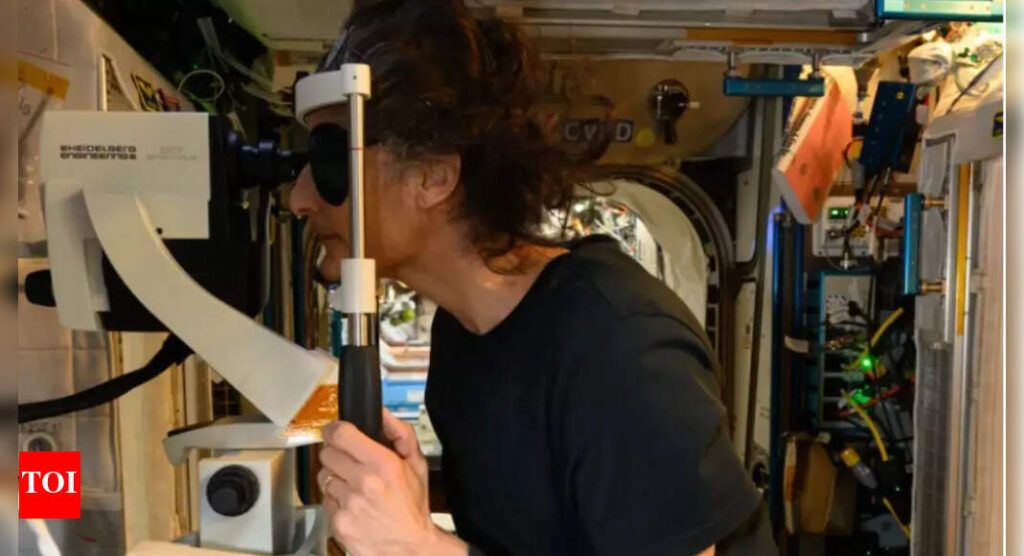
Spending extended periods in zero gravity is no small feat for the human body, and one of the most pressing concerns emerging from long-duration space missions is the impact on astronauts’ vision health. As crew members spend six months or more aboard the International Space Station (ISS), NASA has documented a range of eye-related symptoms, now grouped under the condition called Space-Associated Neuro-Ocular Syndrome (SANS). Fluid shifts in microgravity drive the phenomenon and could present serious challenges for deep space missions like those to the Moon or Mars.
When astronauts began staying in space for longer durations, subtle but troubling changes in their eyesight became increasingly common. Many noticed the sudden need for stronger reading glasses, while flight surgeons and researchers identified specific physiological changes such as swelling of the optic disc and flattening of the eyeball. These symptoms are now collectively known as Space-Associated Neuro-Ocular Syndrome (SANS), and represent a critical health risk that could hinder long-term human space exploration.
Understanding the Causes of SANS
One of the primary factors contributing to SANS is the redistribution of fluids in the absence of gravity. On Earth, gravity pulls fluids toward the lower body. But in microgravity, blood and cerebrospinal fluid tend to move toward the head. This “headward” shift increases pressure in the skull and behind the eyes, potentially leading to structural changes.
To address this, NASA is currently testing the Thigh Cuff experiment, in which astronauts wear tight bands around their thighs to trap blood in the lower body. If successful, this could prevent or even reverse the upward fluid migration—and may also help patients on Earth dealing with similar issues due to bed rest or certain diseases.
Research Efforts and Diagnostic Advancements
NASA and its global partners have conducted numerous pioneering studies to better understand SANS. Among the most important was the Fluid Shifts Study (2015–2020), which offered direct evidence of changes in how blood drains from the brain in weightlessness. The Vision Impairment and Intracranial Pressure (VIIP) project further investigated the link between fluid shifts, increased brain pressure, and SANS symptoms.
Researchers used an array of high-tech tools to gather data, including comprehensive eye exams, high-resolution retinal imaging, MRI scans of the optic nerves, and non-invasive measurements of retinal thickness. Subjective insights were gathered through astronaut questionnaires, offering a fuller picture of the effects of spaceflight on vision.
NASA advances diagnostic tools to monitor and manage SANS:
- Head-mounted virtual reality (VR) displays for multimodal vision assessments
- Optic nerve sheath diameter monitoring as a noninvasive diagnostic tool
Additionally, there is a strong push for standardized imaging protocols across studies to ensure consistent results and faster development of countermeasures.
Genetic Insights and Potential Solutions
Beyond fluid shifts, researchers are looking into how spaceflight alters eye tissue and even gene expression. Canadian teams using Optical Coherence Tomography (OCT) found mechanical changes in astronauts’ eyes akin to those seen in conditions like glaucoma. Japanese studies involving mice showed changes in DNA and gene activity in the optic nerve and retina after spaceflight. Interestingly, early findings suggest that artificial gravity might help mitigate these effects.
A notable recovery case further highlighted possible solutions: one astronaut experienced significant improvement in SANS symptoms after six months in orbit. Recovery correlated with B vitamin supplementation and reduced CO₂ levels in the cabin—suggesting that nutrition and environmental controls could play a vital role in managing risk.
Implications for Future Space Missions
Ongoing research into SANS is crucial, not just for astronaut safety on the ISS but for future exploration missions to the Moon, Mars, and beyond. Moreover, these investigations may lead to medical breakthroughs here on Earth—especially for patients suffering from conditions involving fluid imbalances and ocular pressure disorders.
NASA’s work to unravel the causes of SANS and develop effective treatments is a vivid reminder that the challenges of space travel often illuminate new frontiers in human biology and healthcare innovation. As space agencies continue to push the boundaries of human exploration, understanding and mitigating the health risks of space travel remain paramount.






